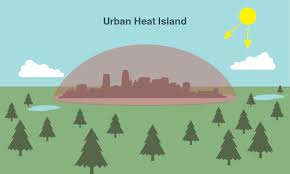Urban Heat Island:

The Telangana Socio-Economic Outlook 2025 report reveals that Hyderabad is experiencing increased nighttime heat stress due to the urban heat island effect.
- The UHI effect is a climatic phenomenon observed in urban areas, where temperatures are significantly higher than in surrounding rural areas.
- This discrepancy in temperature is attributed to human activities and urban development, which alter land surfaces and environments.
- It is the result of an accumulation of factors, the main ones being:
- Reduced green spaces and natural soils: Urbanization contributes to shrinking vegetation in cities (trees, lawns, etc.), resulting in insufficient shading and evapotranspiration, a process that naturally cools the air.
- Density of buildings and infrastructure: Concrete or asphalt buildings and roads store more heat than vegetated areas, thus exacerbating urban warming.
- Narrow streets and tall buildings create urban canyons where warm air is less able to circulate, amplifying the effect of UHIs.
- Heat released by human activities: Road traffic, air conditioning systems, and industrial activities generate heat, which is then trapped by greenhouse gases (such as carbon dioxide) that act as a barrier.
- The combined effect of all these factors, together with global warming and increasingly high temperatures, leads to the development of this urban microclimate.
- The term “Urban Heat Island” originates from the visual representation of temperature distribution maps, where urban areas are depicted as “islands” of higher temperatures amidst cooler rural “seas.”
- The heat of the sun is absorbed during the day, only to be released very slowly at night, which limits the cooling of the air, thus contrasting with the cooling in the outlying rural areas.
- Temperature differences at night can be as much as 12°C.




